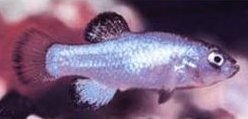Teufelskärpfling
| Teufelskärpfling | ||||||||||||
|---|---|---|---|---|---|---|---|---|---|---|---|---|

Teufelskärpfling ( Cyprinodon diabolis ) |
||||||||||||
| Systematics | ||||||||||||
|
||||||||||||
| Scientific name | ||||||||||||
| Cyprinodon diabolis | ||||||||||||
| Wales , 1930 |
The Teufelskärpfling or Teufelsloch-Wüstenkärpfling ( Cyprinodon diabolis ) is a rare species of fish from the genus of the desert fish . It was discovered in 1890 and scientifically described in 1930.
description
The Teufelskärpfling reaches a length of 2 to 3.4 cm. The head is large and the anal fin is long. The pelvic fins are missing. Males ready to mate are deep blue and have a black band on their caudal fin.
Way of life
The main food is diatoms . In earlier times, the stock was mainly regulated seasonally by the algae supply. In summer, when there was a lot of algae, the population increased to 500 to 700 animals, in winter when there was little algae supply, it fell to 200. The Teufelskärpfling spawns all year round. This can rather prevent the entire species population from becoming extinct.
habitat
The world's only population is limited to a small 5 x 3.5 x 3 m limestone basin located above a hot water spring ( Devils Hole ) in Ash Meadows , Nye County , Nevada . Temperatures here range from 32 to 38 ° C. Devils Hole is located at a depth of 15 meters.
Up until the beginning of 2016, scientists suspected that the ancestors of the devil fish came to Death Valley two to three million years ago, when the area still featured rivers and lakes instead of desert. From a genetic analysis of the fish species and related species in the wider area by researchers at the University of North Carolina , it was concluded that the vampire fish had reached its present habitat at least 800 years ago.
Danger
This species of fish has been under nature protection since 1952. The main threat is the change in habitat. A pumping station near Ash Meadows and the Hoover Dam have ensured that the water level no longer rises, so that this species is acutely threatened with extinction. In 2005 there were only 84 copies left. In April 2006, the population dropped to just 38 adults and 11 juveniles. A census in April 2009 showed 70 individuals. The population has continued to increase slightly since then. A little over 100 animals were registered just a short time after the last survey. Researchers attribute the slight recovery to a seasonal cooling of the water temperature, which is a more favorable climate for the reproduction of this fish species. In the 2013 spring and autumn census, 35 and 65 specimens were found, the lowest level since the beginning of the inventory. In spring 2015 83 and in autumn 2015 131 copies were counted. The 2016 spring census showed 115 specimens. However, one specimen was killed after drunks contaminated the fish's habitat with beer cans, vomit and underwear.
An attempt to breed the species in human care failed in 2006. In 2014 it was proposed to undertake a new attempt in which not live specimens are taken into custody for breeding, but fish eggs are collected. The removal of live animals for breeding purposes could lead to the collapse of the severely shrunk population. The removal of eggs would also avoid exposing live animals to shock from changing environmental conditions.
In the medium term, there will also be threats from the ongoing climate change. According to a study from 2014, the water in the basin now heats up faster, so that the optimal conditions for the hatching of the fish eggs no longer exist for an average of ten, but only nine weeks.
2014 was the IUCN status of "endangered" ( vulnerable ) to "threatened with extinction" ( critically endangered ) changed.
Sources and further information
literature
- Nigel Sitwell : Wildlife '73. Südwest Verlag, Munich 1973.
- Richard Dana Ono, James D. Williams, Anne Wagner: Vanishing Fishes of North America. Stonewall Press, Washington DC 1983, ISBN 0-913276-43-X .
- John R. Paxton, David Kirshner: Encyclopedia of the Wildlife: Fish. Orbis Verlag, Munich 1993.
- David Stephen Lee et al. a .: Atlas of North American Freshwater Fishes. North Carolina State Museum of Natural History, Raleigh 1980, ISBN 0-917134-03-6 .
Web links
- Further information (Engl.) ( Memento of 5 June 2003 at the Internet Archive )
- Teufelskärpfling on Fishbase.org (English)
- Cyprinodon diabolis inthe IUCN Red List of Threatened Species 2014.1. Listed by: NatureServe, 2014. Retrieved January 30, 2015.
- Ash Meadows National Wildlife Refuge Map Page
- Video about the Teufelskärpfling from USFWS
- Cyprinodon diabolis - endemic fish in Devil's Hole of the Nevada desert
Individual evidence
- ↑ John R. Paxton and David Kirshner: Encyclopedia of the Wildlife: Fish. Orbis Verlag., Munich 1993.
- ^ Lothar Seegers: Killifishes of the world - New world killis . Aquaristik - Consulting & Service GmbH, 1997
- ↑ Larissa Tetsch: The fish that lives in the middle of the desert. Süddeutsche Zeitung, March 16, 2016, p. 14
- ↑ The Washington Post : Endangered fish dies after 'idiots' litter its habitat with beer cans, puke and underwear of May 10, 2016
- ^ University of California Berkley: Biologists try to dig endangered pupfish out of its hole , Sept. 9, 2014
- ↑ American Geophysical Union: Heating up the fishbowl: Climate change threatens endangered Devils Hole pupfish , August 26, 2014